Take the right-hand strand and pass it over the strand to the left.
Take the left-hand strand and pass it over the strand to the right and repeat alternately from left to right.

FLAT FOUR PLAIT

Lay the four strands side by side. Take the right-hand strand as in Fig. 1 and lay it over the strand to the left.

Now take the outside left-hand strand as in Fig. 2 and lay it under the next strand to itself and over what was the first strand.

Take the outside left strand and put it under and over, the next two strands respectively moving towards the right.
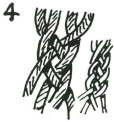
Thereafter your right-hand strand goes over one strand to the left, and your lett-hand strand under and over to the right, as shown in Fig. 4.
BROAD PLAIT

To commence. Take six, seven or more strands, and hold them flat and together.
Take a strand in the centre and pass it over the next strand to the left, as in Fig. 1.

Take the second strand in the centre to the left and pass it towards the right over the strand you first took so that it points towards the right as in Fig. 2.
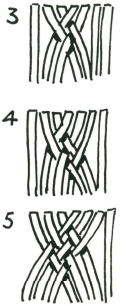
Now take the next strand to the first one and weave it under and over as in Fig. 3.
Weave the next strands from left and right alternately towards the centre as in Fig. 4, 5, 6.

The finished plait should be tight and close as in Fig. 7.
TO FINISH OFF

Take one of the centre strands, and lay it back upon itself as in Fig. 1.
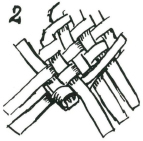
Now take the first strand which it enclosed in being folded back, and weave this back upon itself as in Fig. 2.
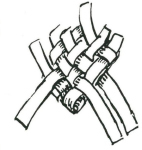
Take a strand from the opposite side, and lay it back and weave it between the strands already plaited.

All the strands should be so woven back that no strands show an uneven pattern, and there should be a regular under-over-under of the alternating weaves.
If you have plaited tightly there may be a difficulty in working the loose ends between the plaited strands.
This can be done easily if you sharpen a thin piece of wood to a chisel edge, and use this to open the strands sufficiently to allow the ends being finished to pass between the woven strands.
Roll under a bottle to work smooth after finishing off.
ROUND OR LARIAT PLAIT . . . FOUR STRANDS

1. Lay the four strands together side by side, as in Fig. 1, and cross the right-hand centre strand over, and then around the left-hand strand.

2. Take the left-hand outside strand, and pass it over the two crossed strands, and then under the right-hand one of the two, so that it is pointing towards the left, as in Fig. 2.

3. Take the free right-hand strand, and pass it over the two twisted strands to the left and completely round the left-hand one of the two, as in Fig. 3.
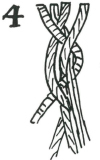
4. Repeat this with the outside left-hand strand as in Fig. 4.

5. Repeat with the right-hand strand as in Fig. 5.
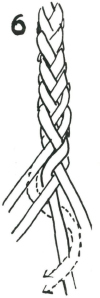
6. The finished plait should look like this.
CLIMBING WITH FOOTLOCK
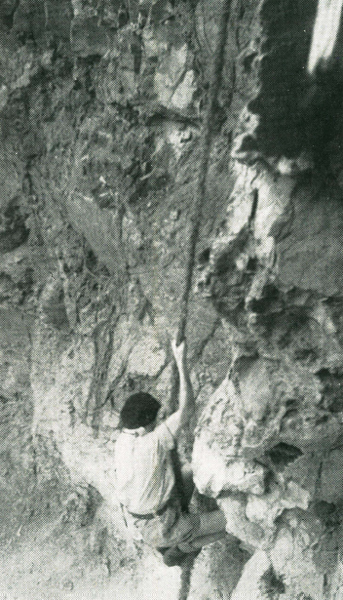
Ascent of a cliff face, using a footlock on a grass rope. The grass rope was 3 strand 3 lay of 2 inches diameter.
CAUTION
Prior to trusting your life to a bush-made rope, always test it. Tie one end to a tree and put three or four fellows onto the other end. Have them take the strain gently until finally all their weight is on the rope. If they cannot break it, then it is safe for one man at a time to use it to climb or descend a cliff face.
When climbing up a bush-made rope always use the footlock, and when descending never slide down the rope. Climb down again using the same footlock.
![]()
The footlock offers a measure of safety, and the climber is so secure that he can actually stand on the rope and rest without his body weight being carried entirely on his arms. To prove this, use the footlock, and clasp the rope to your body with your arms. You will find that you are ‘standing’ on the rope and quite secure.
By means of the footlock you can climb to any height on the rope, stopping to rest when your arms tire.
The footlock is made by holding onto the rope with both hands, lifting the knees, and kicking the rope to the outside of one foot. The foot on the opposite side to the rope is ‘pointed’ so that the toe picks up the rope, which is pulled over the foot which was against the rope, and under the instep of the foot which ‘picked’ it up.
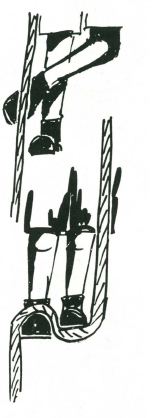
The two feet are brought together, and the rope is now over the instep of one foot, and under the ball of the other. Then, to secure the grip, and lock the rope; the feet are placed one on top of the other so that the rope is clamped down by the foot on top.
By straightening the knees, and raising the hands, the body is lifted, and a fresh grip taken for the next rise.
In descending, the body is bent, the hands lowered, and the footlock released, and a fresh grip taken with the feet at a lower level on the rope.
It is advisable to wear boots or shoes when climbing bush-made ropes.
This method of descending is much safer than sliding. In sliding there is grave risk of bad rope burns to hands and legs.
‘ABSYLE’ FOR ROCK DESCENT
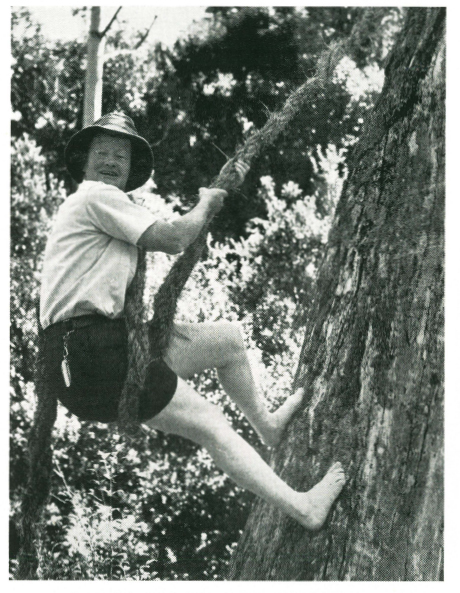
Photo with acknowledgment to “S.M. Herald”
Absyle used for descending rock face. This bush-made grass rope is 3 strand 3 lay of about 2 inches diameter. Breaking strain approx. 400 lbs.
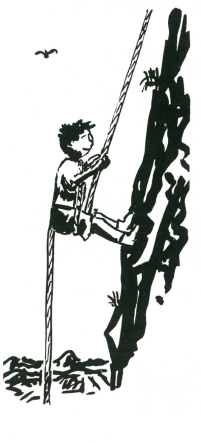
The ‘Absyle’ is used for rock work, generally for descending, though it can be used on some faces for ascent.
In the ‘Absyle’ the body is upright, but the legs are stretched out, and the feet pressed against the rock face.
The rope passes down between the thighs, around one thigh and diagonally up and across the upper half of the body and over the shoulder opposite to the leg under which it passes. The rope may be gripped with one hand.